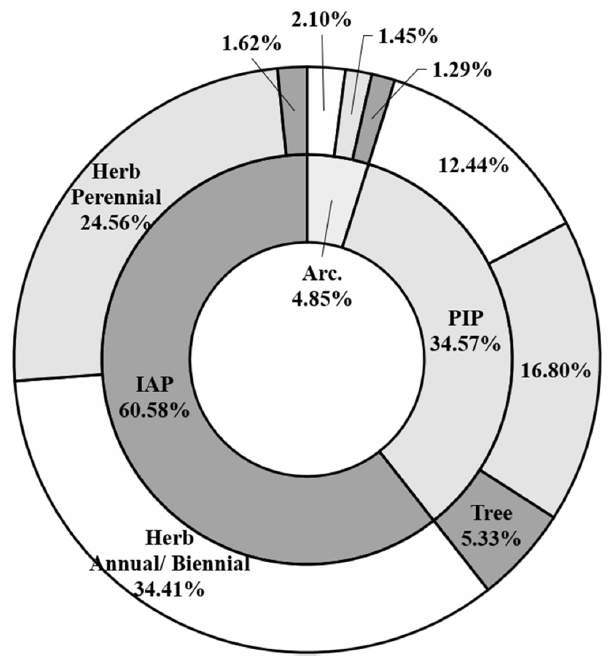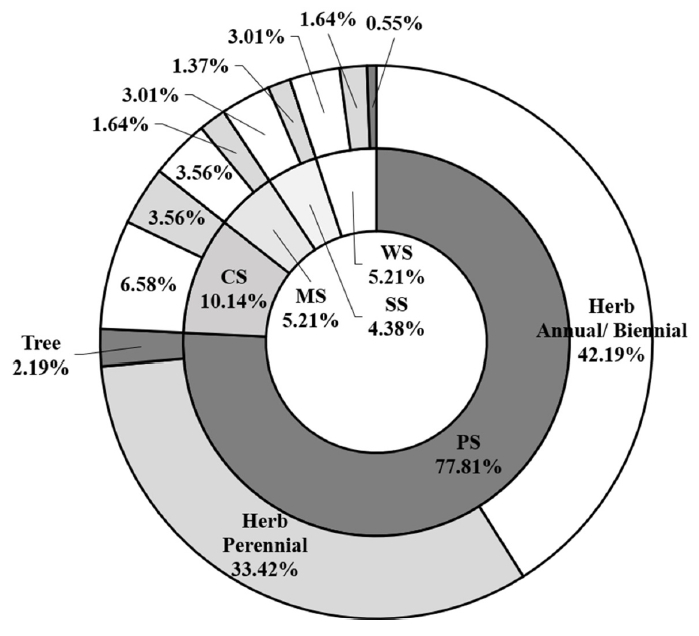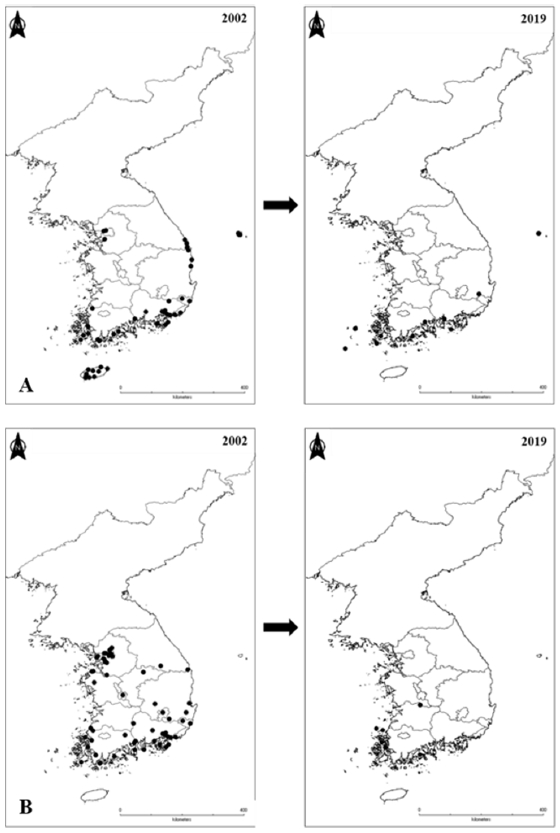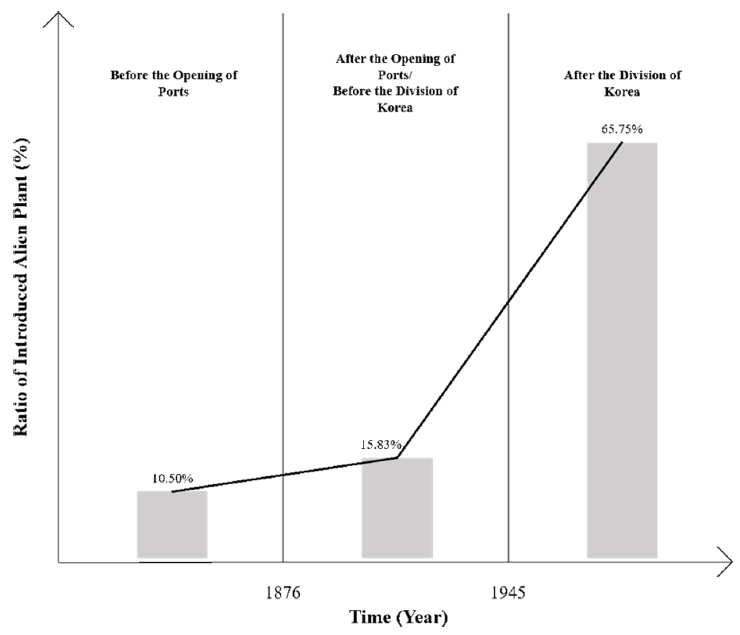국내 외래식물의 현황
Comprehensive review about alien plants in Korea
Article information
Abstract
세계화에 따른 국제교류가 증가함에 따라 외래식물의 국내 유입 또한 증가하고 있다. 외래식물이 자연생태계에 미칠 수 있는 여러 부정적인 영향들이 알려지면서 전 세계적으로 자생식물의 보전을 위한 국가차원의 관리 및 여러 정책들이 수행되고 있지만, 국내의 경우 이들의 현황 파악조차 미흡한 실정이다. 본 연구는 국립수목원에서 수행하는 ‘외래식물 다양성 변화 및 위험성 평가’ 과제의 일환으로 수행된 연구결과 중 일부로, 국내에 유입되어 정착화되었거나, 재배지로부터 일출되어 자연생태계로 확산 가능성이 높은 외래식물의 현황을 파악하였고, 산림청 국립수목원을 비롯한 타부처 외래식물 목록과 관련 주요 도감 및 문헌들을 재검토하였다. 또한 이들을 원산지, 도입시기 및 정착 여부에 따라 체계화하였고, 침입외래식물로 분류되는 외래식물들은 국내 분포정보를 바탕으로 확산정도를 등급화 하였다. 그 결과 국내에 분포하는 외래식물은 96과 353속, 595종, 6아종, 11변종, 1품종, 6잡종의 총 619분류군으로 파악되었으며, 이 중 사전귀화식물 30분류군, 잠재침입식물 214분류군이었고, 침입외래식물은 총 375분류군으로 5등급(widespread, WS)이 19분류군, 4등급(serious spread, SS) 16분류군, 3등급(concerned spread, CS) 19분류군, 2등급(minor spread, MS) 37분류군, 1등급(potential spread, PS) 284분류군으로 나타났다. 외래식물은 앞으로도 계속 유입될 것이고, 이들의 분포 또한 환경 및 기타요인에 의해 변하기 때문에 지속적인 현황파악이 수행되어야 한다.
Trans Abstract
Species invasions have rapidly increased due to the substantial growth of global trade in the recent past. As the awareness of the negative effects on natural ecosystems derived from alien species has grown, many countries and lawmakers have enacted rules and policies on the conservation of indigenous plants. Unfortunately, in Korea, research on species invasion is seriously lacking despite the growing number of alien species. In the current study, we report alien plants that have intentionally and/or unintentionally been introduced in Korea and also presented a checklist of invasive plants found both in the literature and in field surveys. We reviewed all documented records of alien plants, i.e., scientific papers, illustrated books, and annual reports. We also categorized alien plants by origin, time of introduction, naturalization, and the rate of their spread. The results revealed that there are 619 alien plant taxa (96 families, 353 genera, 595 species, 6 subspecies, 11 varieties, 1 forma, and 6 hybrids) occurring in Korea. Among these, 30 taxa are archaeophytes (Arc.), 214 are potentially invasive plants (PIPs), and 375 are invasive alien plants (IAPs). In addition, IAP taxa consist of grades 5 (widespread, WS) to 1 (potential spread, PS) of alien plants according to the rate of spread in Korea. Our results suggested that the number of alien plants is likely to keep growing; thus, the distribution should be regularly monitored and the list of alien plants must be updated.
국내로 유입되는 외래식물(alien plant)은 해마다 증가하고 있다. 이들은 식용, 약용, 원예용 등 의도적인 목적을 가지고 도입된 것이 자연생태계로 일출되기도 하지만, 대부분 사람이나 물류가 이동하는 과정에서 함께, 혹은 인접 국가에서 해류에 떠밀려오는 등 비의도적으로 유입된다. 외래식물은 자연생태계의 변화를 야기할 뿐만 아니라 인류의 건강 또는 경제적, 기술적인 부분 등 여러 측면에서 부정적인 영향을 미칠 수 있다(Van Wilgen et al., 2001; Pimentel, 2005; Sandvik et al., 2013; Mazza et al., 2014). 이들이 생태계의 구성원으로서 자생종들과 어우러져 생물 다양성을 증진시킨다는 긍정적인 견해도 있지만(Lee et al., 2011), 대부분 자생종의 생육지 파괴 및 생태계 교란, 생물다양성 감소, 경관 훼손, 농작물 수확량 감소 등 부정적인 영향이 많다는 견해가 일반적이며(Higgins et al., 1999; Pimentel et al., 2001; Liu et al., 2006; Weber et al., 2008; Gaertner et al., 2009; Rembold et al., 2017), 최근에는 기후변화에 따른 이상기후현상이 외래식물의 확산을 가속화시킬 수 있다는 우려로 외래식물에 대한 부정적인 인식이 더욱 늘어나고 있는 추세이다.
국내에서는 미국실새삼(Cuscuta pentagona Engelm), 돼지풀(Ambrosia artemisiifolia L.)과 같은 외래식물의 전국적인 확산으로 자연생태계에 부정적인 영향을 주는 사례 (Lee et al., 2015a; Oh et al., 2015; Jung et al., 2017)들이 보고되면서 외래식물에 대한 주의를 기울이기 시작하였다. 이에 따라 외래식물을 관리하기 위한 연구와 효과적인 방제 대책을 수립하고자 노력하고 있는 가운데 귀화식물(naturalized plant, NP), 침입외래식물(invasive alien plant, IAP), 생태계교란식물 등 외래식물 관련 다양한 용어들이 사용되고 있다. 그러나 외래식물 관련 용어들의 정의와 범주는 정확한 기준과 체계가 수립되지 않아 연구자마다 다른 의미로 인식하거나 오용되고 있는 경우가 흔하다 (Sun et al., 2002; Hyun and Kwon, 2006). Richardson et al. (2000)은 외래식물에 대한 기준과 용어가 명확히 확립되어 있지 않을 경우 무분별한 혼용으로 인해 외래식물의 생태적 상태를 설명하거나 관리계획을 세우는 데 있어 혼란을 초래할 수 있음을 지적한 바 있으며, 이러한 문제를 인식하고, 해결하고자 Jung (2014)은 자생식물(native plant)과 외래식물, NP, 사전귀화식물(archaeophyte, Arc.), IAP 등 외래식물 관련 용어를 정리하였으며, IAP를 유입 시기와 토착화 진행에 따라 임시귀화식물(causual naturalized plant), NP로 세분하였다. 이후 Jung et al. (2016)은 외래식물의 유입시기, 토착화 진행, 국내 분포 여부에 따라 외래식물을 Arc., 잠재침입식물(potentially invasive plant, PIP [관심외래식물(concerned alien plant, CAP), 불확실종(uncertain plant, UN)]), IAP (임시정착식물[casual alien plant, CAP], NP)로 체계화하였다.
우리나라의 외래식물 현황 연구는 Lee and Kim (1961)이 좀땅빈대(Euphorbia hypericifolia L.), 금달맞이꽃(Oenothera odorata L.), 달맞이꽃(Oenothera lamarckiana Seringe), 둥근잎유홍초[Quamoclit angulata (Lam.) Bojer], 독말풀(Datura tatula Mill.), 부리새(Dactylis glomerata L.), 망초[Conyza canadensis (L.) Cronquist], 개망초[Erigeron annuus (L.) Pers.] 총 8분류군의 NP를 제시한 것으로 시작되었다. 이후 Yim and Jeon (1980)이 국내 200개 지역에서 27과 110분류군을, Kang and Shim (2002)은 1984년부터 국내 외래식물의 자생지를 조사하여 재배식물을 포함한 NP 총 471분류군을 보고하였다. Lee et al. (2011)은 NP 321분류군을 귀화도(naturalized degree)와 함께 목록을 보고하였고, Jung (2014)은 IAP, NP를 포함한 다른 외래식물들의 용어 정리와 함께 IAP 290분류군의 원산지, 개화기 등의 특징과 분포도를 작성하였으며, Kill and Kim (2014)은 NP의 원산지와 도입되어 확산된 해외 국가 목록과 함께 총 309분류군을, Ryu et al. (2017)은 NP 326분류군의 생태형질 특성을 보고한 바 있다.
한편 최근 발견되는 외래식물은 전국 분포조사에서 발견된 미기록 외래식물을 학계에 보고함으로서 인식되었고, 2017년 이후 보고되고 있는 외래식물의 수는 매년 늘어나고 있는 추세이다(Ryu et al., 2017; Kim et al., 2018; Ryu et al., 2018; Kim et al., 2019a, 2019b, 2019c). 분류군 수가 늘어나는 원인에는 세계화 및 물류확대로 외래식물 유입 빈도가 증가하고, 생물다양성협약(convention on biological diversity, CBD) 체결 이후 자생식물 보전을 위한 외래식물의 관심 증가, 인터넷 발달에 따른 국가간의 생물정보 공유를 통한 외래식물 정보에 대한 접근성 용이 등으로 판단된다(Park, 2007; Hong, 2014).
외래식물의 관리방안과 중장기계획을 세우기 위해 이들의 현황과 유입 경로 및 생태에 미치는 구체적인 영향을 파악해야 하지만, 그 중에서도 우선, 계속해서 새롭게 유입되는 외래식물들을 파악하여 목록을 최신화하고, 기존에 제시되었던 목록에 대해서는 출현 여부와 분류학적 처리 여부 등으로 재검토하여 신뢰성이 있는 목록을 제시하며, 응용이 용이하도록 체계화시키는 것이 필요하다. 미기록 외래식물의 보고는 계속해서 늘어나고 있는 반면, 이들의 현황에 관한 연구는 2017년 이후로 최신화가 이루어지지 않았다. 기존에 보고된 외래식물의 현황목록들은 보고되었던 외래식물들의 출현 여부 및 분포변화, 새롭게 발견된 미기록 외래식물에 대한 정보를 담고 있지 않기 때문에 현재 현황 목록의 재검토 및 최신화가 이루어져야 할 시점으로 보인다.
본 연구는 국립수목원에서 수행하는 외래식물 다양성 및 위험성 평가과제 일환으로 수행된 연구결과 중 하나로, 국내 외래식물의 현황을 파악하기 위해 산림청 국립수목원을 비롯한 타부처 외래식물 목록과 관련 주요 도감 및 연구 논문들을 재검토하여 국내 분포하는 것으로 확인된 외래식물종의 원산지와 특징을 포함한 외래식물 목록을 현행화하였다. 또한 이들 중 IAP로 분류되는 외래식물들은 분포양상을 파악하여 확산등급을 제시하였다.
재료 및 방법
목록의 작성은 국내 외래식물 관련 문헌(Park, 2009; Lee et al., 2015b; Kim and Kil, 2017; Shin et al., 2017; Kim et al., 2018; Lee and Lee, 2018)과 논문(Ryu et al., 2017; Kim et al., 2018; Ryu et al., 2018; Kim et al., 2019a, 2019b, 2019c), 타 부처 기관의 외래식물 목록(Lee et al., 2015b; National Institute of Biological Resources, 2019)을 조사하여 2019년까지 국내에 분포하는 것으로 확인된 종과 일출 사례가 있거나 가능성이 높은 종을 선별한 뒤 Jung et al. (2016)의 기준에 근거해 체계적으로 분류하였고(Table 1), 이들의 생활형 및 원산지, 유입시기를 조사하였다. 이들의 학명과 국명은 국립수목원의 국가표준식물목록(Korea National Arboretum, 2017)과 국가표준재배식물목록(Korea National Arboretum, 2016)을 기준으로 정리하였으며, 일부 분류군의 계급변화나 이명처리 등은 Tropicos (2019), The Plant List (2019)와 기타문헌을 참고하여 보완 및 수정하였다. 목록의 순서는 과의 경우 Engler의 분류체계에 따라(Melchior and Werderman, 1954; Melchior, 1964) 배열하고, 과 이하의 속명, 종소명 등은 알파벳 순으로 배열하였다. 원산지는 전 세계를 6개의 대륙으로 구분하여(Fig. 1), 원산국가가 속해 있는 대륙으로 정리하였고, 유입시기는 개항(1876년) 전후와 분단(1945년) 전후로 나누어 분류하였다. 또한 IAP는 시·군단위의 분포지역 수에 근거하여 국내 분포정도를 등급으로 평가하였다(Table 2, Appendix 1).

Type of alien plants classified by time of introductions, level of naturalization and invasion capacity.

Map of origins for alien plants currently occurring in Korea. The color gradients represent each of six continent. Acronyms for each region are provided in parentheses.
결 과
국내 외래식물 현황
국내 분포하는 외래식물은 96과 353속 595종 6아종 11변종 1품종 6잡종의 총 619분류군으로 확인되었다. 이 중 양치식물이 2분류군(0.32%), 나자식물이 5분류군(0.81%), 피자식물의 쌍자엽식물이 475분류군(76.74%), 단자엽식물이 137분류군(22.13%)으로 구성된다(Table 3). 이들 중 높은 비율로 차지하고 있는 주요 10과는 벼과가 100분류군(16.16%)으로 가장 많았으며, 그 다음으로 국화과가 90분류군(14.54%), 십자화과 42분류군(6.79%), 콩과 42분류군(6.79%), 석죽과 21분류군(3.39%), 가지과 21분류군(3.39%), 마디풀과 16분류군(2.58%), 비름과 16분류군(2.58%), 아욱과 16분류군(2.58%), 미나리과 14분류군(2.26%)으로 나타났다(Table 4).

The number of alien plants that are in the taxonomic groups with the largest number of alien taxa by 10th order.
외래식물 목록에서 기존에 NP로 지정되었던 좀개소시랑개비(Potentilla supina L. var. ternate Peterm)와 큰닭의덩굴[Fallopia dentatoalata (F. Schmidt) Holub], 닭의덩굴[Fallopia dumetorum (L.) Holub]은 동아시아와 구대륙에 넓게 분포하고 있고, 외래식물로 판단할 수 있는 국내외 자료가 미흡해 기존 원산지 표기의 착오로 판단하여 제외시켰으며(Li and Park, 2003; Li et al., 2003; Jung, 2014; Jung et al., 2016), 분류학적 실체에 논란이 있었던 붉은양장구채[Silene gallica L. f. quinquevulnera (L.) W. D. J. Koch], 털들갓[Sinapis arvensis L. var. orientalis (L.) W. D. J. Koch & Ziz] 등의 18분류군은 최근 분류학적 견해에 따라 이명처리하였다(Table. 5) (Jung, 2014; Jung et al., 2016). 2018년부터 2019년 동안 발표된 미기록종인 병풀아재비(Bowlesia incana Ruiz & Pav.), 깃털장대(Sisymbrium irio L.), 좀전동싸 리[Melilotus indicus (L.) All.], 가는잎가시상추(Lactuca saligna L.), 나도뿔이삭풀[Hainardia cylindrica (Willd.) Greuter], 날개카나리새풀(Phalaris paradoxa L.), 주름전동싸리(Melilotus officinalis (L.) Lam.), 꽃여뀌바늘[Ludwigia peploides (Kunth) P. H. Raven subsp. montevidensis (Spreng.) P. H. Raven], 연자주쥐손이(Geranium robertianum L.), 털개구리자리(Ranunculus sardous Crantz)의 10분류군(Fig. 2) (Ryu et al., 2017; Kim et al., 2018; Ryu et al., 2018; Kim et al., 2019a, 2019b, 2019c)과 일반적으로 재배종이지만 살비아(Salvia officinalis L.), 페퍼민트(Mentha × piperita L.), 양다래[Actinidia chinensis Planch. var. deliciosa (A. Chev.) A. Chev] 등의 귀화목록에 실린 적이 있거나, 재배지에서 벗어나 야생에서 발견되어 보고된 식물들 또한 PIP의 CAP로 분류하여 목록에 포함시켰다(Korea National Arboretum, 2016; Kim and Kil, 2017).
외래식물의 분류
국내 유입시기와 정착 여부에따라 Arc., PIP, IAP로 구분하였다(Table 1). Arc.는 개항(1876년) 이전에 유입된 것으로 추측되고, 자세한 유입시기 및 경로를 밝히기 어려운 토착화된 외래식물들로 자리공(Phytolacca acinosa Roxb.)과 괭이밥(Oxalis corniculata L.) 등이 여기에 속하며, PIP는 의도적인 도입에 의해 재배되고 있지만, 자연생태계에 확산 가능성이 있는 PIP (CAP)와 기존에 IAP이었으나, 분포 여부가 불확실한 PIP (UN)로 구성된다. IAP는 국내에 의도 또는 비의도적으로 유입되어 야생화된 것으로 정착 여부에 따라 IAP (NP)와 IAP (CAP)로 세분화하였다.
외래식물들을 상기와 같이 분류하였을 때, Arc.는 30분류군(4.85%), PIP는 PIP (CAP) 151분류군(24.39%)과 PIP (UN) 63분류군(10.18%)으로 총 214분류군(34.57%)이었다. IAP는 IAP (CAP) 109분류군(17.61%)과 IAP (NP) 266분류군(42.97%)의 총 375분류군(60.58%)으로 가장 높은 비율을 보였다(Table 6).
생활형별로는 Arc.와 IAP에서 1–2년생이 각각 2.10%, 35.22%로 다년생과 목본보다 높은 비율을 차지하고 있었고(Fig. 3), PIP는 다년생이 21.97%, 1–2년생이 12.60%으로 다년생이 더 많았다. 재배종이 주로 속하는 PIP와 달리 야생화되어 있는 Arc.와 IAP의 경우 1–2년생이 높은 비율을 보이고 있어, 1–2년생이 다년생보다 다른 환경에서의 적응 및 정착이 쉽게 일어난다는 것으로 볼 수 있다. 1–2년생 식물들은 다년생 식물들보다 짧은 생활환을 가지고 있어 환경이 열악하더라도 스트레스를 회피할 가능성이 높아 사멸될 가능성이 적으며(Lee et al., 2011), 빠른 생육과 번식으로 수광, 무기물 등, 주위 식물과의 자원경쟁에서도 유리하여 야생화가 쉽게 일어나는 것으로 보인다.

Proportion of the categorized alien plant types. The inner circle shows the proportions of the classified types by time of introductions, level of naturalization and invasion capacity. The outer circle indicates the proportions of life cycle types.
한편 PIP에서 목본의 비율은 다른 분류들의 목본 비율보다 높은 것을 볼 수 있으며, 이와 같은 결과는 목본 식물이 국내에 비의도적으로 도입되어 야생화가 되는 경우보다, 관상용 등으로 의도적으로 도입되어 식재하는 경우가 많기 때문으로 판단된다.
외래식물별로 주요 10과를 함께 보았을 때(Fig. 4), 벼과 식물이 가장 많은 분류군 수를 가질 뿐만 아니라, IAP의 비율도 80.00%로 가장 높았다. 이는 벼과 식물이 육지나 습지 등, 서식처의 종류가 다양하며, 알맞은 환경 조건이 갖추어졌을 경우 생육 및 번식이 빠르기 때문에 다른 과들보다 비율이 높은 것으로 생각된다. 미나리과 식물은 PIP의 비율이 50.00%로 다른 과들과 비교해 보았을 때 가장 높았다. 미나리과 식물들은 옛날부터 약용, 식용으로 들여 사용해왔기 때문에 이와 같은 결과가 나온 것으로 보인다(Jung et al., 2016; Kim and Kil, 2017).
원산지
원산지별 중 아시아 원산이 32.31%로 가장 높았고, 그 다음으로 유럽 원산 26.08%, 북아메리카 17.23%, 남아메리카 12.18%, 아프리카 10.79% 오스트레일리아 1.49%으로 나타나 북아메리카 원산 혹은 유럽 원산의 비율이 가장 높게 나온 Lee et al. (2011), Kil and Kim (2014), Ryu et al. (2017)의 현황 조사결과와 달랐다(Fig. 5). 이는 현재까지 지속된 외래식물의 유입과 더불어 과 거의 현황이 IAP (NP)만을 대상으로 조사한 것과 달리, 본 연구에서는 IAP (NP)를 포함해 토착화 과정에 있는 외래식물 혹은 야생화되어 확산될 가능성이 있는 재배 식물을 포함하였기 때문인 것으로 보인다. 아시아 원산이 가장 많은 이유로는 주변 국가이기 때문에 식물의 유입이 다른 대륙들에 비해 쉽게 일어날 수 있다고 생각할 수도 있지만, 아시아와의 교류는 과거부터 현재까지 계속 활발히 이루어지고 있을뿐만 아니라, 옛날부터 약용, 관상용으로 식물들을 많이 수입해 외래식물의 유입이 많은 것으로 보이며, 이는 아시아의 Arc.와 PIP의 비율이 다른 대륙들에서 보다 높게 나타난 것으로도 유추할 수 있다.
생활형과 함께 보았을 때, 모든 원산들에서 공통적으로 초본의 1–2년생, 다년생, 목본 순으로 많은 것으로 나타났으나 그 가운데, 아시아 원산의 목본 비율이 3.95%로 1%도 안되는 다른 대륙들 보다 높은 것을 알 수 있다(Table 7). 이와 같은 결과는 옛날부터 은행나무(Ginkgo biloba L.)와 같이 중국에서 종교가 전파되면서 들어오거나, 양버들(Populus nigra L.), 계수나무(Cercidiphyllum japonicum Siebold & Zucc. ex J. J. Hoffm. & J. H. Schult. bis)처럼 산림녹화용, 관상용으로 아시아 원산의 나무를 주로 들여와 식재하는 경우가 많았기 때문에 나타난 결과로 판단된다. 위 추측은 앞서 보았던 외래식물 분류에 따른 생활형에서 PIP의 목본 비율이 다른 외래식물들에서보다 많았던 결과가 뒷받침해줄 수 있을 있을 것으로 보인다. 아시아 다음으로 많은 원산은 유럽으로, 원예종 식물들이 유럽으로부터 많이 수입되기도 하지만, Korea Customs Serviece (2020)에서 제공하는 대륙별 수출입 실적을 보면 수출입은 북아메리카가 유럽보다 더 많은 편이었다. 따라서 유럽의 외래식물이 직접적으로 우리나라에 도입되는 경우보다 거리가 가까운 대륙인 아시아나 우리나라와 교류가 많은 북아메리카를 거쳐 들어오는 경우가 많은 것으로 보이며, 특히, 북아메리카는 과거 유럽의 식민지였던 이후로 유럽으로부터 많은 물류 이동이 있었기 때문에 북아메리카를 거쳐 국내로 들어온 유럽 원산의 외래식물이 많을 것으로 예상된다.
유입시기
외래식물의 유입은 1876년 개항 이전에 65분류군(10.50%), 개항 이후에서 분단 이전까지 98분류군(15.83%), 1945년 분단 이후 407분류군(65.75%)으로 나타났다(Fig. 6). 분단 이전에는 관련 문헌이 미흡하고, 일제강점기와 제 2차 세계대전의 영향으로 인해 교류할 수 있는 국가가 한정되어 있어 분류군 수가 적게 나타난 것으로 보인다. 1945년 이후에는 국내 식물 분류학 혹은 생태학과 같은 자연과학의 발달로 식생 조사가 이루어지고, 교류하는 국가 또한 증가하여 외래식물의 발견과 유입이 많아졌기 때문에 다른 시기들보다 분단이후 시기에서의 비율이 큰 차이로 높게 나타난 것으로 생각된다. 세계화가 진행되고 있는 현 상황에서 외래식물 유입은 앞으로도 계속될 것으로 보이며, 유입되는 양도 지금보다 증가할 가능성이 있는 것으로 판단된다.
침입외래식물(invasive plant, IAP)의 확산정도
외래식물의 시·군별 분포정보를 바탕으로 IAP 분류군의 국내 분포등급을 설정하였으며, 그 결과 가장 넓은 분포를 보이는 5등급(widespread, WS)은 애기수영(Rumex acetosella L.), 미국자리공(Phytolacca americana L.), 좀명아주(Chenopodium ficifolium Sm.), 족제비싸리(Amorpha fruticosa L.), 돼지풀(Ambrosia artemisiifolia L.) 등 총 19분류군(5.07%)이었고, 4등급(serious spread, SS)은 16분류군(4.27%), 3등급(concerned spread, CS) 19분류군(5.07%), 2등급(minor spread, MS) 37분류군(9.87%), 1등급(potential spread, PS) 284분류군(75.73%)로 나타났다(Table 2). 등급별 생활형을 보았을 때, 3등급을 제외한 모든 등급에서 1–2년생의 비율이 높았으며(Fig. 7), 외래식물 구분에 따른 생활형에서 본 결과와 마찬가지로 짧은 생활환을 가지는 1–2년생 식물들이 확산에도 유리한 것으로 보인다. 목본은 5등급과 1등급에서만 나타났고, 5등급은 2분류군(0.55%), 1등급에서 8분류군(2.19%)이었다. 여기서 5등급인 식물은 아까시나무(Robinia pseudoacacia L.)와 족제비싸리(Amorpha fruticosa L.)이었으며(Fig. 8), 둘은 번식력이 강한 것으로 알려진 식물일 뿐만 아니라 과거에 산림 녹화용으로 들여와 많이 식재되었으므로, 다른 목본류들보다 국내에 넓게 확산되어 있는것으로 생각된다.

Proportion of spread types across different life-cycle types. The inner circle shows the proportion of the types classified by the spread rates, while the outer circle indicates the proportion of the life cycle types for the alien species in Korea. WS, widespread; SS; serious spread; CS, concerned spread; MS, minor spread; PS, potential spread.

Distribution of V (widespread) degree (see Table 2 for the acronym). A. Rumex acetosella L. B. Rumex crispus L. C. Phytolacca americana L. D. Stellaria media (L.) Vill. E. Chenopodium ficifolium Sm. F. Amorpha fruticosa L. G. Robinia pseudoacacia L. H. Trifolium repens L. I. Oenothera biennis L. J. Veronica arvensis L. K. Veronica persica Poir. L. Ambrosia artemisiifolia L. M. Bidens frondosa L. N. Conyza canadensis (L.) Cronquist O. Erechtites hieraciifolius (L.) Raf. ex DC. P. Erigeron annuus (L.) Pers. Q. Galinsoga quadriradiata Ruiz & Pav. R. Taraxacum officinale F. H. Wigg. S. Dactylis glomerata L.
침입외래식물(invasive plant, IAP)의분포변화
IAP에 속하는 종들 중 과거 분포역 대비 내륙에서 확장 또는 감소 등 분포에 변화가 있거나[개양귀비; Papaver rhoeas L., 애기수영; Rumex acetosella L., 양명아주; Dysphania ambrosioides (L.) Mosyakin & Clemants, 큰비짜루국화; Symphyotrichum expansum (Poepp. ex Spreng.) G. L. Nesom], 제주도에 제한적인 분포를 보였던 외래식물이 내륙으로 확장한 종[방울새풀; Briza minor L., 애기달맞이꽃; Oenothera laciniata Hill]의 분포 및 분포등급 변화를 보았다.
과거보다 분포역이 넓어져, 분포등급이 높아진 외래식물은 개양귀비와 애기수영으로, 개양귀비는 1등급(PS)에서 2등급(CS), 애기수영은 3등급(MS)에서 5등급(WS)으로 높아졌다(Fig. 9). 개양귀비는 관상용으로 많이 심기 때문에 자연적으로 확산되었다기보다는, 식재된 것이 관리 부주의로 인하여 자연생태계로 일출된 경우가 많을 것을 보이며, 이들의 종자 또한 다른 원예작물과 함께 이동되어 재배지가 아닌 곳에도 자라는 경우도 많을 것으로 생각된다. 애기수영은 종자가 사람의 활동뿐만 아니라, 바람, 동물 등에 의해 자연적으로 확산되기도 하며, 이 중 물에 의해서도 확산하는 것으로 알려져 있다(Jung et al., 2015). 하천 주변에 애기수영이 자라는 것은 많이 볼 수 있으며, 여기서 자란 이들의 종자들이 물에 산포되고, 넓은 지역으로 확산되어 그 결과 과거에 해안가 주변으로 주로 분포하고 있던 것이 현재는 내륙뿐만 아니라 육지와 떨어진 섬까지 확산된 것으로 추측된다. 양명아주와 큰비짜루국화는 과거에 2등급이었으나 현재는 내륙과 북쪽지역의 분포역이 줄어들어 1등급으로 나타났다(Fig. 10). 이는 식물의 오동정이나 분포조사의 미흡의 결과로도 볼 수 있지만, 이들의 생태적인 특징으로 인한 분포의 변화로도 보인다. 양명아주와 큰비짜루국는 남아메리카와 미국의 남부지역이 원산이며, 두 종 모두 해안이나 강과 같은 물가에서 자라는 것으로 알려져 있다. 따라서 이들의 분포는 내륙으로 퍼지지 못하고, 북부지역에도 점차 사라져 주로 남부지역의 해안가에만 남아있는 것으로 생각된다. 하지만, 큰비짜루국화의 경우에는 최근에도 강화도, 경기도에서도 발견되고 있으므로 여전히 북부지역의 해안가, 강가, 하천가에 이들의 분포지가 있는 것으로 생각된다(Lim et al., 2014; Kim et al., 2015; Kim et al., 2018). 방울새풀과 애기달맞이는 과거와 현재 모두 1등급으로 분포등급이 동일하였다(Fig. 11). 하지만, 제주도에만 국한되어 있던 분포역이 전라남도 서해안 지역 혹은 남부 해안지역으로 넓혀진 것을 볼 수 있었으며, 이와 같은 결과를 볼 때, 분포등급의 결과가 과거와 현재 동일하더라도 외래식물의 확산 가능성은 완전히 배제할 수 없을 것으로 보인다.

Increases of distributions for two alien plants in Korea. The figures on the left represent the distributions in 2002 (Park et al., 2002), while the ones on the right represent the distributions in 2019. A. Papaver rhoeas L. B. Rumex acetosella L.

Reductions of distributions of two alien plants in Korea. The figures on the left represent the distributions in 2002 (Park et al., 2002), while the ones on the right represent the distributions in 2019. A. Dysphania ambrosioides (L.) Mosyakin & Clemants B. Symphyotrichum expansum (Poepp. ex Spreng.) G. L. Nesom.

Changes in the distributions of two alien plants in Korea. The figures on the left represent the distributions in 2002 (Park et al., 2002), while the ones on the right represent the distributions in 2019. A. Briza minor L. B. Oenothera laciniata Hill.
위의 결과들은 외래식물의 분포역과 분포등급이 인위적인 간섭이나 주변 환경변화에 의해 변할 수 있으며, 이들의 정확한 분포조사 및 모니터링과 위험성 평가는 지속적으로 진행되어야할 필요가 있다. 적절한 시기에 외래식물의 분포변화 파악 및 확산 정도에 대한 재평가가 이루어져, 외래식물의 효과적인 관리계획을 세우기 위한 유용한 정보의 하나로써 제공되어야 할 것이다.
고 찰
세계적으로 일부 외래식물들의 빠른 확산으로 인해 자생식물의 서식처 침범과 생태계 교란을 일으키는 사례가 보고면서 외래식물에 대한 부정적인 측면이 부각되고 있으며, 국내에서도 서양등골나물[Ageratina altissima (L.) R. M. King & H. Rob.], 물참새피(Paspalum distichum L.), 서양금혼초(Hypochaeris radicata L.)를 포함한 총 14종의 외래식물들이 생태계 교란종으로 지정되어 있다(Ministry of Environment, 2017). 하지만, 모든 외래식물이 생태계에 위협되는 것은 아니며, 이들은 또한 산림과 같은 자연식생에서는 보기 드물고, 주변 환경과 인위적 간섭에 따라 분포와 확산이 다르게 일어난다. 따라서 이들을 모두 생태계 위협대상으로만 보는 것이 아니라, 지속적인 모니터링을 통해 구체적인 정보 바탕으로 위험성을 판단해야 될 것으로 보이며, 같은 이유로 외래식물을 효율적으로 관리하기 위해선 무조건적인 제거 방법보다 자연식생을 복원하는 방향으로 관리방안을 세우는 것이 중요하다(Lim and Hwang, 2006; Lim et al., 2009; Lee et al., 2011). 분홍안개꽃[Psammophiliella muralis (L.) Ikonn.], 후미푸사선인장[Opuntia humifusa (Raf.) Raf.], 특히, 최근 전국에 많이 식재되고 있는 핑크뮬리[Muhlenbergia capillaris (Lam.) Trin.]처럼 재배하는 외래종일 경우에도 야생화 되어 생태계에 부정적인 영향을 줄 수 있는 가능성을 내포하고 있기 때문에 이들이 자연으로 일출되지 않도록 예방차원에서 재배지 주변 식생을 모니터링하고 관리하는 것이 필요하다.
외래식물들의 국내 유입은 기하급수적으로 증가하고 있으며, 이들은 새로운 지역에서 적응유무에 따라 소멸되거나 토착화가 진행된다. 환경에 의해서도 이들의 분포역이 계속 변할 수 있기 때문에 이미 귀화되었거나 소멸된 것으로 보이는 외래식물일지라도 지속적인 현황파악을 통한 재검토가 이루어져야 할 것이며, 신뢰성 있는 목록을 만들어 외래 식물에 관한 연구 및 관리계획을 세우기 위한 기본적인 정보로써 제공되어야 할 것이다.
Notes
Conflict of Interest
The authors declare that threr are no conflicts of interest.









